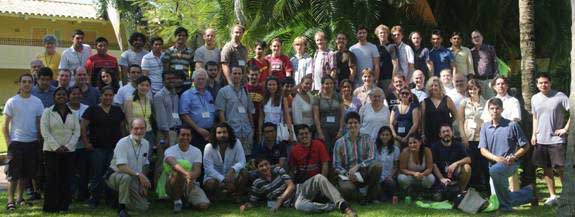CAM 2009: Physics Knows No Borders...
Ivelisse Cabrera

CAM 2009 participants
From October 22-24, students from all across North America met in Acapulco, Guerrero, Mexico to participate in the 4th Annual Canada-America-Mexico Physics Graduate Students Conference.
The Canada-America-Mexico (CAM) Physics Graduate Students conference is a joint meeting of the Canadian, American and Mexican Physical Societies focusing on graduate students' education. The aim of this event is to provide an outstanding opportunity for students to develop professional skills, learn a broad range of physics topics, and initiate interactions across geographical borders. Furthermore, it fosters communication and exchange of ideas among students of various backgrounds and interests.
CAM 2009 was held from October 22-24 in Acapulco, Guerrero, Mexico. The conference was a success. There were 136 participants from all North America who had the opportunity to present their research work to fellow international students in a relaxed setting. Topics included particle physics; astrophysics and cosmology; nanostructures; fundamental physics phenomena; applied physics; superconductivity; and nuclear, atomic, and molecular physics. The conference was perfect for networking. Participants had fun during CAM and enjoyed the students’ talks, the invited talks given by renowned scientists, and the panel discussion.
Panel Discussion Summary
Towards the end of the conference, a panel discussion titled: "New Frontiers in Physics: Interrelations of Physics and Other Disciplines (Medicine, Biology, Geosciences, Nanosciences, etc)" was held. Panel members included David Ernst (president of the Board of Directors for the National Society of Hispanic Physicists and member of the American Physical Society Executive Board), Gordon W. F. Drake (director of International Affairs of the Canadian Association of Physicists and editor of the Physical Review A), Luis Felipe Rodriguez (president of the Mexican Physical Society), and Michael Steinitz (editor of the Canadian Journal of Physics).
Below are some of the points discussed:
- There is a desire to keep departments tied to fundamental fields (e.g., physics, chemistry), while allowing for multi or interdisciplinary activities and research. Universities should keep defined and separate boundaries between fields.
- It was suggested to include more interdepartmental courses during a student's undergraduate years to expose them to other disciplines at an early stage or their education.
- There is a current problem with high school physics teachers, where lack of resources prevents them from continuing research while teaching.
Final advice offered by panel members to graduate students:
- “Help prepare high school teachers or become a high school teacher.“
- “Pick one thing/topic and become an expert on it.”
- “Be unique. Read articles from other fields. Attend colloquia. Work on your networking skills.
- “Trust the system. Learn to communicate in English.”
More information about CAM 2009 can be found at: http://cam2009.smf.mx/. A Facebook group has also been created for CAM 2009 at: http://www.new.facebook.com/group.php?gid=161881349445&ref=ts .
The CAM 2009 organizing committee would like to thank all participants for their high-quality presentations and active participation during all sessions of CAM 2009.
If you missed CAM 2009, you don’t want to miss CAM 2011!
Ivelisse Cabrera is the FGSA International Student Affairs Officer and a graduate student in physics at the Johns Hopkins University.
Disclaimer - The articles and opinion pieces found in this issue of the APS Forum on Education Newsletter are not peer refereed and represent solely the views of the authors and not necessarily the views of APS.
